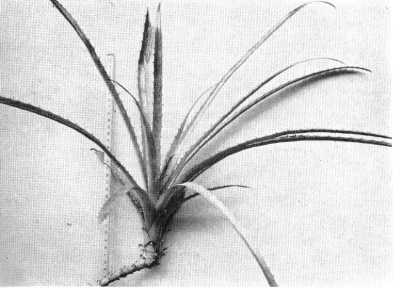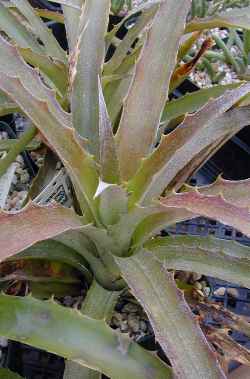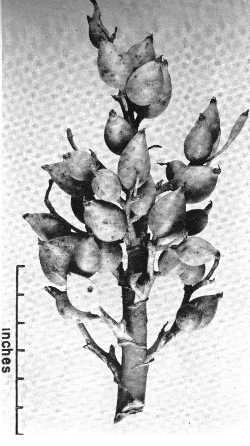Pinguin, Piñuela
Scientific Name: Bromelia pinguin L.
Synonym: Agallostachys fastuosa
Family: Bromeliaceae
USDA: 9b-12
Frost Tolerance: Hardy to 28°F (-2°C) for short periods
Sun Exposure: Full sun to light shade
Origin: Tropical Americas, Caribbean
Growth Habits: Clumping rosette, 4 feet tall (1.2 m), up to 10 feet wide (3 m)
Watering Needs: Regular to abundant water in summer, keep dry in winter
Propagation: Offsets, seeds

The genus name 'Bromelia' comes from a prominent Swedish medical doctor and botanist, Olof Ole Bromell (1639-1705).
The Pinguin, native to tropical America, produces a compact rosette that may contain as many as 40 leaves. The stiff, linear, long-attenuate leaves are up to 2 inches across and a to 6 feet in length. They are serrated and armed with sharp, recurved prickles. Most of the prickles curve toward the leaf apex but an occasional one curves toward the base. The leaves gradually change from a shiny green to a reddish color as they age. The white or pinkish flowers are produced on a dense panicle that arises from the heart of the plant.
The leaves of this plant yield a strong fiber, pinguin, which can be used as substitute for jute.

Bromelia aff. pinguin HBG 61563, ISI 99-36
Blooming Habits:
The youngest leaves are pinkish while the flower is developing. The flower stem has up to 100 pinkish red flowers. The main rosette dies after blooming.
Fruiting Habits:
The ovoid, pointed fruits are 1 to 2 inches in length and turn yellow at maturity. The main fruiting season is from May to November, though fruit can occasionally be found during the remainder of the year The small amount of pulp is acid but makes an excellent refreshing drink. It is a fair source of calcium and vitamin C. The pinguin also is a source of a protein-splitting enzyme, pinguinain. This enzyme can be used as a meat tenderizer, and the juice of the fruit has been utilized as an anthelmintic.
Propagation:
The pinguin naturally reproduces vegetatively by means of thick runners that usually are produced above ground. It is usually propagated by separating the runner plants from the parent, but seeds sometimes are used.
Desert-Tropicals is dedicated to provide gardening advice, gardening ideas, and information about flower of all kind for landscape and collections.We try to check carefully the identification of the plants on the illustrations as well as the other information from the page, but occasionally errors do occur. if you notice anything that needs to be changed please contact us.Thanks.
© 1998-2020 Philippe Faucon, All Rights Reserved.
